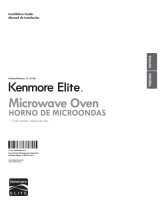
3
Instrucciones de instalación
INSTRUCCIONES DE SEGURIDAD IMPORTANTES
Un electricista calificado debe realizar una verificación
de continuidad de conexión a tierra en el tomacorriente
de pared antes de comenzar la instalación para
garantizar que la caja de distribución tenga una
adecuada conexión a tierra. Si no cuenta con una
adecuada conexión a tierra, o si el tomacorriente de
pared no cumple con los requisitos eléctricos indicados
(bajo REQUISITOS ELÉCTRICOS), debe contratarse
un electricista calificado para corregir las deficiencias.
ADVERTENCIA
Riesgo
de descarga eléctrica. Puede
provocar una lesión o la
muerte: Quite el fusible o el
interruptor de circuitos de la
vivienda antes de comenzar
la instalación para evitar una
lesión por descarga grave o
fatal.
ADVERTENCIA
Riesgo
de descarga eléctrica. Puede
provocar una lesión o la
muerte: ESTE APARATO
DEBE CONTAR CON UNA
ADECUADA CONEXIÓN
A TIERRA para evitar una
descarga grave o fatal.
El cable eléctrico de este
aparato está equipado con un
enchufe de tres patas (con
conexión a tierra), lo cual
requiere que el mismo encaje
con un tomacorriente para tres
patas (con conexión a tierra)
de pared para minimizar la posibilidad de descargas
eléctricas.
Donde haya un tomacorriente de pared estándar
de dos espigas, resulta indispensable cambiarlo
por un tomacorriente de pared de tres espigas
con adecuada conexión a tierra, instalado por un
electricista calificado.
ADVERTENCIA
Riesgo de descarga eléctrica.
Puede provocar una lesión o la muerte: Bajo
NINGUNA circunstancia corte, deforme o quite las
clavijas del cable de energía. No utilice un cable de
extensión.
No cumplir con esta indicación puede provocar un
incendio.
Asegúrese
de que existe
una conexión
a tierra
apropiada
antes del uso
PRECAUCIÓN
En pos de la seguridad
personal, la superficie de montaje debe ser capaz
de soportar la carga del gabinete, además del
peso adicional (de 63 a 85 libras) de este producto,
más las cargas adicionales del horno de hasta 50
libras
o un peso total entre 113 y 135 libras.
PRECAUCIÓN
En pos de la seguridad
personal, este producto no puede ser
instalado en sistemas de gabinetes tales como los
llamados “islas” o “penínsulas.” Éste debe ser
montado tanto a un gabinete superior como a una
pared.
PRECAUCIÓN
Para evitar el riesgo de una
lesión personal (en la espalda u otras lesiones
debido a peso excesivo del horno microondas) o
daños a la propiedad, hacen falta dos personas
para instalar este horno microondas.
REQUISITOS ELÉCTRICOS
La clasificación del producto es de 120 vatios CA
(AC), 60 hertz, 15 amperios y 1.7 kilovatios. Este
producto debe estar conectado a un circuito de
suministro del voltaje y frecuencia apropiados.
El tamaño del alambre debe conformarse a los
requisitos del National Electric Code o al código local
en efecto para este índice de kilovatios. El cable
eléctrico de alimentación y el interruptor deberán
llevarse a un tomacorriente único conectado a tierra
de 15 a 20 amperios. La caja del tomacorriente
deberá estar localizada en el gabinete encima del
horno. La caja del tomacorriente debe ser instalada
por un electricista calificado y debe conformarse al
National Electrical Code o al código local en efecto.
Éste es el símbolo de alerta de seguridad. El mismo alerta sobre potenciales riesgos que le pueden producir la muerte o
lesiones tanto a usted como a otras personas. Todos los mensajes de seguridad estarán a continuación del símbolo de alerta de
seguridad y con la palabra “PELIGRO”, “ADVERTENCIA” o “PRECAUCIÓN”. Estas palabras se definen como:
PELIGRO
Indica una situación de riesgo que, si no se evita, producirá la muerte o lesiones graves.
ADVERTENCIA
Indica una situación de riesgo que, si no se evita, podría producir la muerte o lesiones graves.
PRECAUCIÓN
Indica una situación de riesgo que, si no se evita, podría resultar en lesiones menores o moderadas.
















































